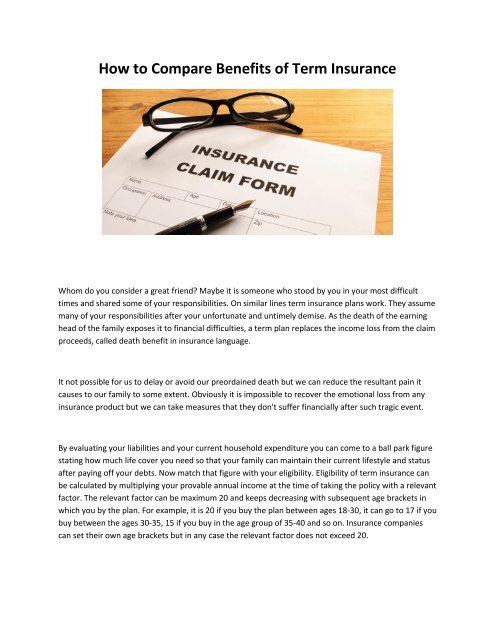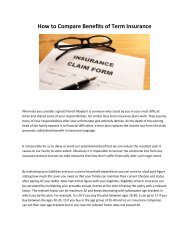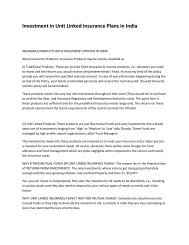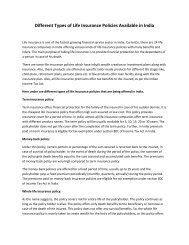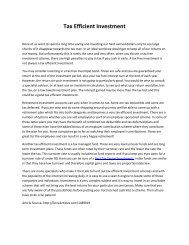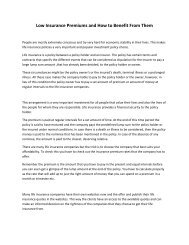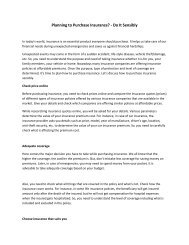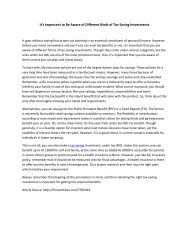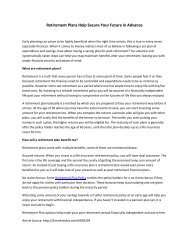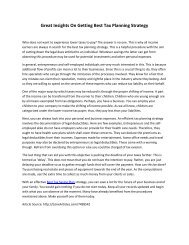How to Compare Benefits of Term Insurance
Create successful ePaper yourself
Turn your PDF publications into a flip-book with our unique Google optimized e-Paper software.
<strong>How</strong> <strong>to</strong> <strong>Compare</strong> <strong>Benefits</strong> <strong>of</strong> <strong>Term</strong> <strong>Insurance</strong><br />
Whom do you consider a great friend? Maybe it is someone who s<strong>to</strong>od by you in your most difficult<br />
times and shared some <strong>of</strong> your responsibilities. On similar lines term insurance plans work. They assume<br />
many <strong>of</strong> your responsibilities after your unfortunate and untimely demise. As the death <strong>of</strong> the earning<br />
head <strong>of</strong> the family exposes it <strong>to</strong> financial difficulties, a term plan replaces the income loss from the claim<br />
proceeds, called death benefit in insurance language.<br />
It not possible for us <strong>to</strong> delay or avoid our preordained death but we can reduce the resultant pain it<br />
causes <strong>to</strong> our family <strong>to</strong> some extent. Obviously it is impossible <strong>to</strong> recover the emotional loss from any<br />
insurance product but we can take measures that they don't suffer financially after such tragic event.<br />
By evaluating your liabilities and your current household expenditure you can come <strong>to</strong> a ball park figure<br />
stating how much life cover you need so that your family can maintain their current lifestyle and status<br />
after paying <strong>of</strong>f your debts. Now match that figure with your eligibility. Eligibility <strong>of</strong> term insurance can<br />
be calculated by multiplying your provable annual income at the time <strong>of</strong> taking the policy with a relevant<br />
fac<strong>to</strong>r. The relevant fac<strong>to</strong>r can be maximum 20 and keeps decreasing with subsequent age brackets in<br />
which you by the plan. For example, it is 20 if you buy the plan between ages 18-30, it can go <strong>to</strong> 17 if you<br />
buy between the ages 30-35, 15 if you buy in the age group <strong>of</strong> 35-40 and so on. <strong>Insurance</strong> companies<br />
can set their own age brackets but in any case the relevant fac<strong>to</strong>r does not exceed 20.
You can buy more than one term plans also in cases you have not bought plans <strong>to</strong> your full eligibility. For<br />
example if according <strong>to</strong> your income and age bracket you are eligible <strong>to</strong> a life cover <strong>of</strong> INR 1 crore and<br />
you have taken a policy <strong>of</strong> INR 40 lacs you can take further plans till you are fully covered for INR 1 crore.<br />
The sum assured on an existing plan cannot be increased. When your income rises your eligibility also<br />
rises, in such event you can buy another plan <strong>to</strong> get a higher cover and have multiple term plans or<br />
surrender the existing plan and buy a new plan with a higher cover.<br />
One important tip is that you buy term plans after comparing the options available in the market. <strong>Term</strong><br />
plans are compared primarily on four bases. These are discussed below.<br />
Premium<br />
One <strong>of</strong> the obvious parameter <strong>to</strong> compare any insurance plan is premium. Especially in case <strong>of</strong> term<br />
plans the premium paid is <strong>of</strong> high importance as it is generally a very long term plan and you wouldn't<br />
want <strong>to</strong> pay higher premium for such long period than you could avail had you done effective<br />
comparison. Another reason why premium comparison is important in your term plan is that in these<br />
plans the premium does not get accumulated and paid at maturity. Absence <strong>of</strong> maturity benefit makes<br />
premium comparison very important.<br />
Plan <strong>Term</strong><br />
It is the duration <strong>of</strong> the life cover. The insurance company is liable <strong>to</strong> pay only when death <strong>of</strong> the insured<br />
occurs during this period. It is favorable for you <strong>to</strong> have a longer life cover <strong>to</strong> remain protected in the<br />
senior years <strong>of</strong> your life in which fatality ratio is high. Go for companies <strong>of</strong>fering a higher plan term.<br />
Claim Settlement Ratio<br />
While comparing the term plans <strong>of</strong> various companies it is very important <strong>to</strong> compare the claim<br />
settlement ratios <strong>of</strong> the insurers. Claim settlement ratio is the ratio <strong>of</strong> number <strong>of</strong> claims sanctioned out<br />
<strong>of</strong> the <strong>to</strong>tal number <strong>of</strong> claims received by the insurance company in a year. Higher claim settlement ratio<br />
<strong>of</strong> the company is indicative <strong>of</strong> increased probability <strong>of</strong> your claim getting passed. Companies with<br />
better claim settlement ratio <strong>of</strong>ten enjoy good reputation and popularity among the cus<strong>to</strong>mers.<br />
Extra <strong>Benefits</strong> or Riders<br />
Few <strong>Insurance</strong> companies <strong>of</strong>fer a range <strong>of</strong> added benefits by charging a little extra on a regular term<br />
plan. These benefits are called riders.<br />
Popular riders available in India are:<br />
Critical Illness Rider: Under this rider the insurance company pays a lump sum amount <strong>to</strong> the<br />
policyholder if and when he is diagnosed with serious disease listed as critical disease. The money<br />
received from the insurance company can be very useful <strong>to</strong> take required treatment.
Accidental Rider: Under this rider the insurance company pays up <strong>to</strong> twice the sum assured <strong>to</strong> the<br />
nominees in cases where the insured dies because <strong>of</strong> an accident. An accident can be any violent<br />
incident <strong>of</strong> physical nature caused by an impact from an external and visible object.<br />
Disability Rider: Under this rider the insurance company pays a portion <strong>of</strong> the sum assured <strong>to</strong> the<br />
policyholder in case he encounters a disability in his body <strong>to</strong> enable him <strong>to</strong> sustain his needs as in case <strong>of</strong><br />
disability earning capacity can be compromised.<br />
There are many other such riders available in the market. You can sit with your agent or on the internet<br />
<strong>to</strong> explore what all riders you need and which companies are <strong>of</strong>fering those. Based on such analysis you<br />
can short list those companies and compare.<br />
Study and scrutinize a large number <strong>of</strong> plans <strong>to</strong> make a smart purchase. Missing out on a lucrative plan<br />
and settle for a mediocre one is not what you want. It is recommended <strong>to</strong> use services <strong>of</strong> various online<br />
insurance comparison portals <strong>to</strong> get an unbiased plan comparison and that <strong>to</strong>o free <strong>of</strong> cost.<br />
<strong>How</strong> <strong>to</strong> <strong>Compare</strong> <strong>Benefits</strong> <strong>of</strong> <strong>Term</strong> <strong>Insurance</strong> http://www.sooperarticles.com/finance-articles/insurancearticles/how-compare-benefits-term-insurance-1510715.html#ixzz4YZawnHGs


